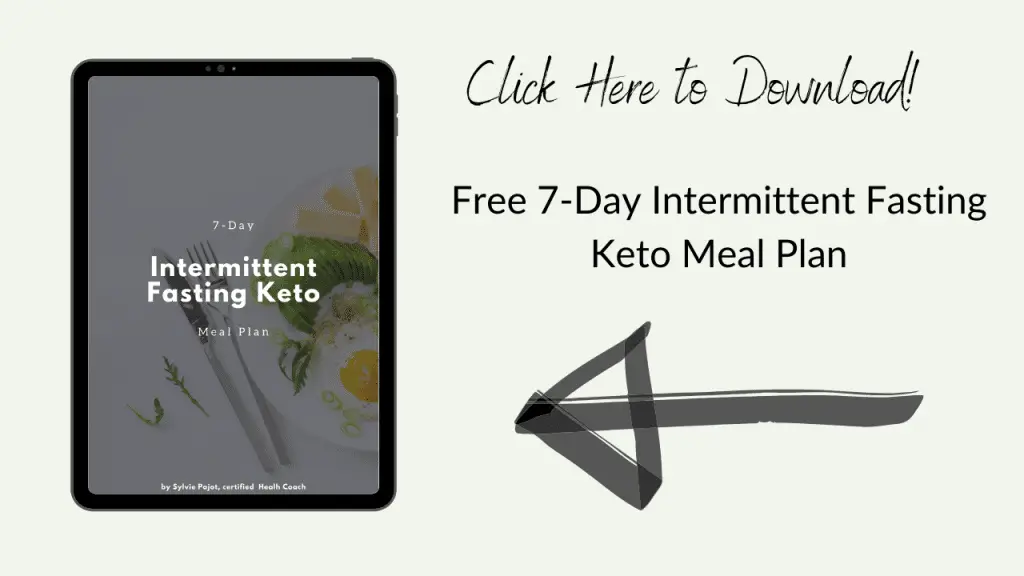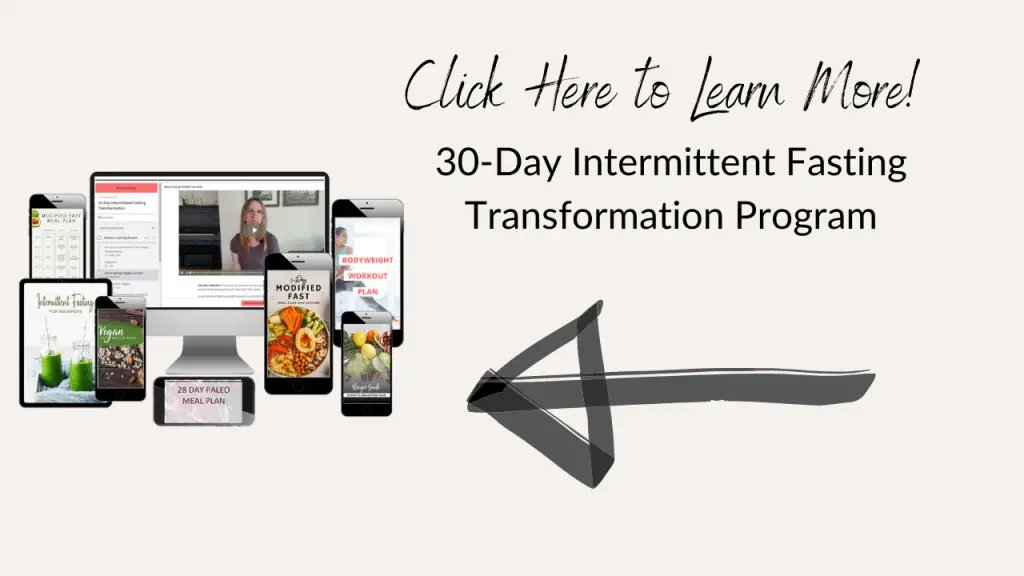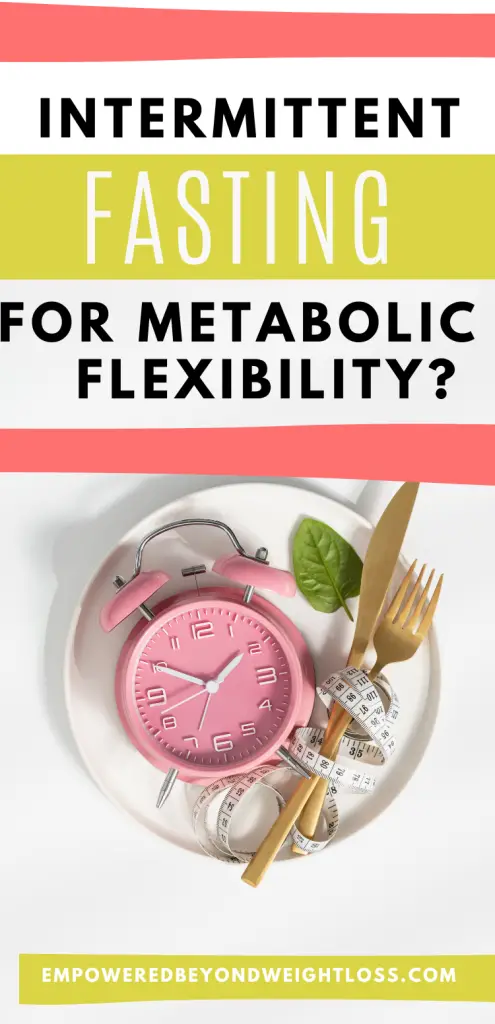In a perfect world, achieving optimal weight and wellness is simple: eat just enough whole foods.
Unfortunately, many of us struggle with:
✖️Our inability to listen to our bodies’ hunger cues
✖️Uncontrollable food cravings
✖️An insatiable appetite
We need to address that before focusing on the basics. That’s where intermittent fasting for metabolic flexibility comes in. In this post, I will review the basics of intermittent fasting for metabolic flexibility. Then, I will explain what resources you can use on my website to get started.

What Is Metabolic Flexibility
Fundamentally, metabolic flexibility defines your body’s ability to switch from glucose to ketones for energy with ease. Once you achieve optimal weight loss ketosis and know how it feels, you will notice that you can spend a week or more without worrying about fasting. Getting back into it won’t be as hard as it used to be. That’s metabolic flexibility.
It means no more feeling “hangry” after 3 hours without food! I think many of us know on a deeper level that we shouldn’t have to eat all the time to feel well. We want to stop feeling like we need to eat every 3 hours. We crave true food freedom and freedom from food. When we find it, we discover that not only doesn’t food preparation take up as much time, but also thinking about food doesn’t take up as much brain space.
Life-changing, right? That’s metabolic flexibility in a nutshell.
Optimal Weight Loss Ketosis
Optimal weight loss ketosis on a ketone monitor sits around 1.0-2.0 mmol/L. To achieve this level with intermittent fasting, you most likely will need to fast longer than 16 hours. In the next section, We will discuss how to use intermittent fasting for optimal weight loss ketosis (and metabolic flexibility). For now, I want you to know how it feels:
- More energy
- Better focus
- Feeling hungry with feeling “hangry”
The first time you notice this, you know that your body is producing enough ketones. It’s nice to confirm by reading your levels on a screen. Consequently, I tend to recommend a ketone monitor like the Keto Mojo.

Using Intermittent Fasting for Metabolic Flexibility
Using intermittent fasting for metabolic flexibility is about achieving optimal weight loss ketosis through fasting regularly. You have to ensure you are fasting long enough on your fasting days without fasting every day. This way, your body will easily adapt and switch from glucose to ketones for energy.
It is helpful to kickstart your optimal weight loss ketosis with a 5-day modified fast or a 7-day keto cycle. This will help ensure that you don’t have to fast as long as you experiment with intermittent fasting. Your lack of metabolic flexibility would make fasting more difficult.

Kickstart Optimal Weight Loss Ketosis
I have often heard health experts explain that once you have been in ketosis, it is easier to get back into it. I never really questioned it because I experienced the difference myself. After feeling ” the switch ” the first time,” I noticed that fasting was much easier. And I didn’t have to fast as long to feel the difference. And that, even after not fasting for a week or more.
I tried to find scientific evidence for this claim (and my experience) and found nothing. I did find some articles about training our cell mitochondria to burn fat more effectively (switch to fat-burning). And that’s what the kickstart that I am recommending is all about. Before experimenting with intermittent fasting for metabolic flexibility, start training your cells for fat-burning with a modified fast or a 7-day Keto Cycle.

5-Day Modified Fast
Modified fasting is the term I chose to talk about any DIY version o the Fasting Mimicking Diet by Dr. Valer Longo. Dr. Valter Long has been studying longevity for decades. Furthermore, he has studied the benefits of fasting and calorie restriction. He devised a 5-day fast that severely restricts calories (you eat only 40 percent of your regular calorie intake and limits protein and carbs to trigger autophagy (as your cells switch to fat-burning).
I created various meal plans you can use to DIY the Fasting Mimicking Diet, read Modified Fasting: How You Can Benefit From Fasting Without Starving to learn more.
7-Day Keto Cycle
You will feel hungry on a modified fast. I am not going to lie! You need some excellent inner motivation and accountability to get to the end of that fifth day. If you don’t think you can get through 5 days of eating only 40 percent of your regular calorie consumption. Another option is a 7-day keto cycle. The advantage of the FMD over a keto cycle is that you won’t feel sick with “the keto flu,” but with a keto cycle, you won’t feel hungry.
I created a 7-Day Intermittent Fasting Keto Meal Plan you can use if this is your preferred option.

Experiment With Intermittent Fasting
Now that you have managed to switch to fat-burning using a modified fast or a keto cycle, it is time to start using intermittent fasting for metabolic flexibility. I have three favorite intermittent fasting methods to enable you to do that. However, there are other effective options like Alternate Day Fasting and OMAD. Do what works best for you. It’s all about learning to listen to your body. It’s your journey!
Intermittent Fasting Methods for Metabolic Flexibility
Here are the three methods I tend to recommend first to use intermittent fasting for metabolic flexibility:
- Warrior Diet: Get my schedule and meal plan here.
- Eat-Stop-Eat Method: Read Intermittent Fasting for Health and Weight Loss: The Eat-Stop-Eat Diet Explained and Why You Should Try a 24-Hour Fast While and After Losing Weight.
- 5:2 Method: Learn how to practice this method and get a meal plan here.
What I like about these three methods is that the longer fasts will allow you to get into ketosis and stay there for a few hours without stressing your body too much, as you won’t fast every day.
I don’t recommend that you fast long enough to get into ketosis more than five days a week. In fact, I often fasted only 3-4 days a week during my own weight loss journey. If you would like additional help and support to achieve your weight loss goals, I offer a digital program as well as one-on-one coaching.

Using Intermittent Fasting for Metabolic Flexibility Video
In Summary
Intermittent fasting is an effective tool to train your body to use fat and glucose for energy. That is why it is incredibly effective for weight loss and overall health. No more uncontrollable food cravings, no tracking calories or macros! Total food freedom as you learn to discover your true hunger cues. Using intermittent fasting for metabolic flexibility has changed my life, so I made it my life goal to help others do the same.




